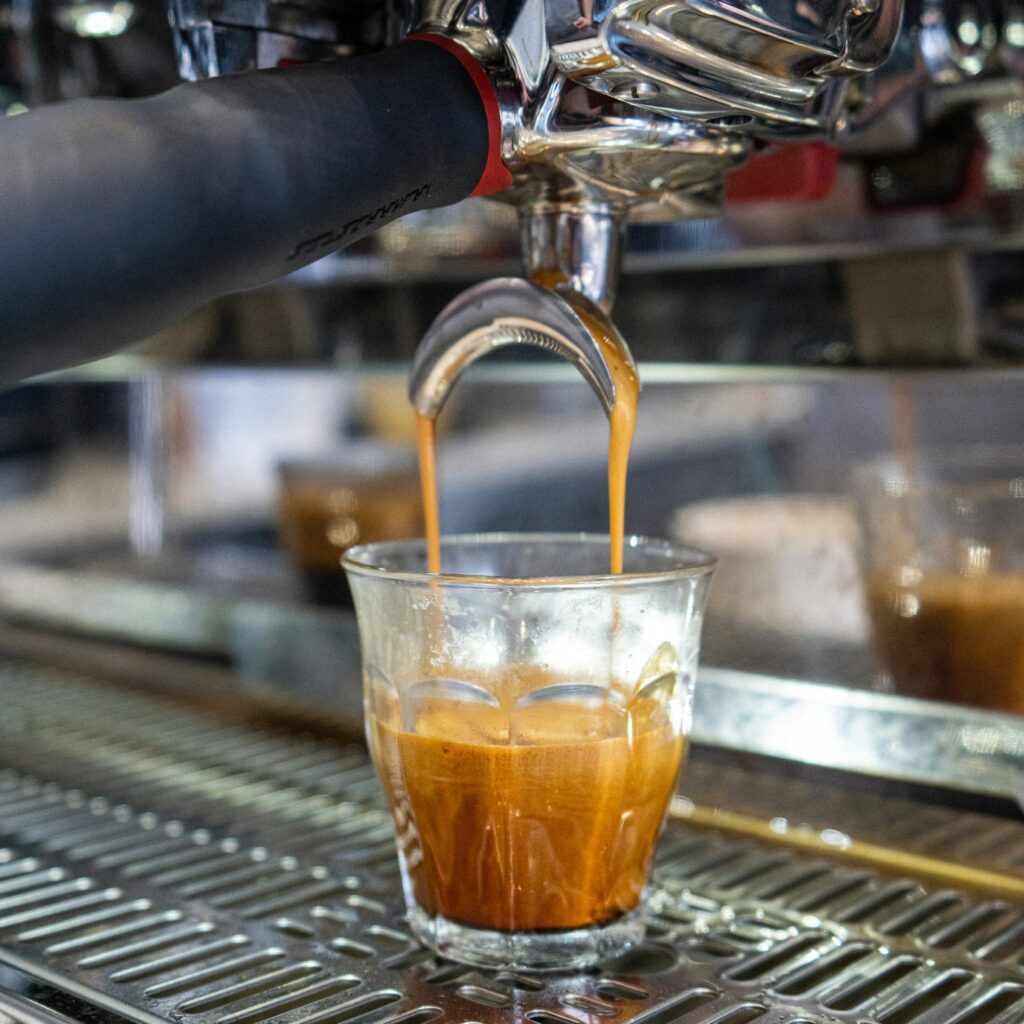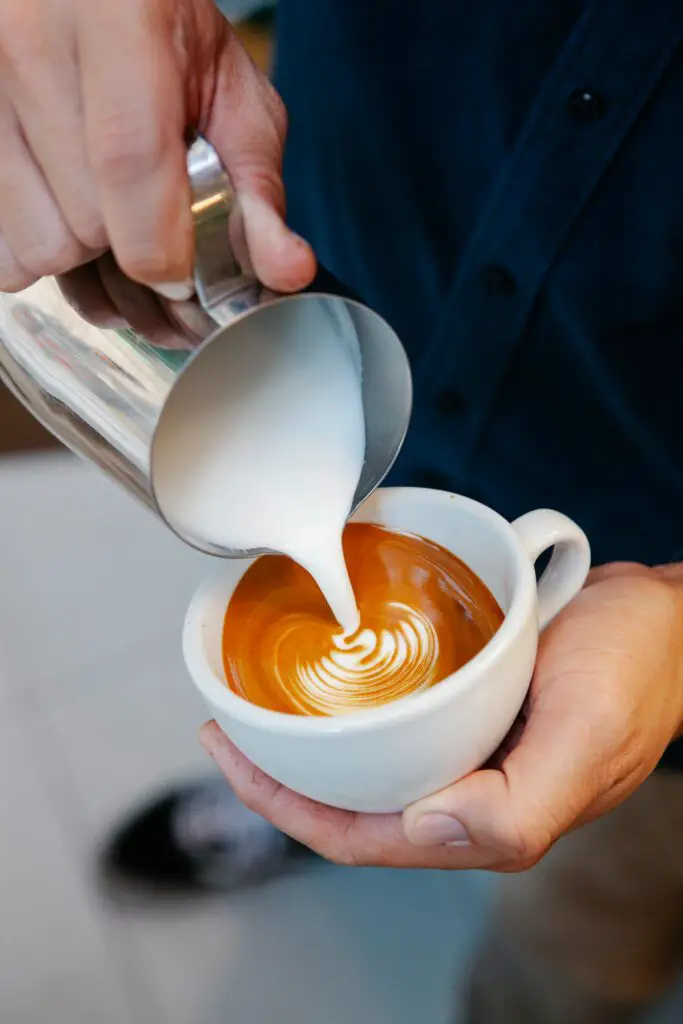A wet cappuccino is a smoother, creamier version of the traditional cappuccino.
It has more steamed milk and less foam, creating a silkier texture that balances the boldness of espresso.
Unlike lattes, which are milkier, wet cappuccinos strike a perfect middle ground for coffee lovers seeking a richer, but not too intense, coffee experience.
Recently, it’s gained popularity among those who enjoy the velvety texture of milk mixed with the espresso’s rich flavor.
Learning how to make a wet cappuccino is a great place to start if you want to elevate your coffee game.

How to Make a Wet Cappuccino: At A Glance
- Brew 1 shot of espresso (about 1 oz).
- Steam 3/4 cup of milk (6 oz) to 150°F (65°C) for a creamy texture with minimal foam.
- Pour steamed milk gently into the espresso, holding back the foam.
- Top with a small cap of foam to complete the wet cappuccino.
What is a Wet Cappuccino?

As we touched on, a wet cappuccino is a variation of the classic cappuccino that focuses on more steamed milk with just a small cap of foam.
This gives it a creamier texture compared to a traditional cappuccino.
While a typical cappuccino consists of equal parts espresso, steamed milk, and foam, a wet cappuccino shifts this balance by reducing the foam and adding more steamed milk.
This results in a smoother, less frothy drink.
In comparison, a dry cappuccino has more foam and less milk, making it feel airier and delivering a stronger espresso taste.
On the other hand, a latte contains even more steamed milk than a wet cappuccino, with just a thin layer of foam on top.
The extra milk in a wet cappuccino softens the intensity of the espresso, creating a milder, sweeter flavor.
It’s a great option for those who enjoy the boldness of espresso but prefer a richer, more velvety texture in their coffee.
Ingredients and Equipment Needed

To make a wet cappuccino, you’ll need a few essential ingredients and tools.
Ingredients
- 1 shot of espresso (about 1 ounce or 30 ml): Use freshly brewed espresso for the best flavor. Avoid over-extracting to keep the taste smooth.
- 3/4 cup of milk (about 6 ounces or 180 ml): Whole milk is recommended for a creamy texture, but you can also use dairy alternatives like:
- Oat milk
- Almond milk
- Soy milk
Equipment
- Espresso machine: This is essential for brewing a quality espresso shot.
- Steam wand: Ideal for steaming milk to the right consistency (smooth, with minimal foam).
- Manual frother or whisk: If you don’t have a steam wand, these tools can help froth the milk without too much foam.
- Milk frothing pitcher: To steam or froth the milk efficiently.
- Thermometer (optional): Helps ensure the milk is heated to the ideal temperature (around 150°F or 65°C).
Step-by-Step Guide on How to Make a Wet Cappuccino

Step 1: Brew the Espresso
Start by brewing a single shot of espresso (about 1 ounce or 30 ml).
If you’re using an espresso machine, grind your coffee beans finely, and tamp them evenly into the portafilter.
Lock it into the machine and pull your shot, aiming for a smooth extraction in around 25-30 seconds.
It’s important not to over-extract, as this can lead to bitterness and overpower the delicate flavors of the milk in your cappuccino.
A properly extracted espresso should be bold but balanced, providing the base for your wet cappuccino.
Step 2: Steam the Milk
Next, steam 3/4 cup of milk (about 6 ounces or 180 ml) to create the smooth, velvety texture needed for a wet cappuccino.
If using a steam wand, position it just below the surface of the milk at an angle to create a gentle whirlpool effect.
This helps incorporate air slowly and creates fewer bubbles, leading to a creamy consistency.
Heat the milk to around 150°F (65°C), which brings out its natural sweetness without scorching it.
Whole milk works best for a rich texture, but oat, almond, and soy milk are great alternatives.
Keep in mind that non-dairy milk can froth differently—oat milk tends to create a creamy texture similar to whole milk, while almond and soy milk may not froth as well.
Step 3: Combine Milk and Espresso
Once your milk is steamed, gently pour it into the espresso.
Start by tilting the cup slightly and pour the milk into the center, allowing the steamed milk to mix smoothly with the espresso.
Hold back the foam with a spoon until the end, creating a small cap of foam on top.
This balance of more steamed milk and less foam is what defines a wet cappuccino.
For an added touch, you can attempt latte art by controlling the pour of the milk to create patterns like a heart or leaf.
Tips for the Perfect Wet Cappuccino

Milk Selection
The type of milk you choose plays a huge role in both the flavor and texture of your wet cappuccino.
Whole milk is the best choice for most because it produces a rich, creamy consistency and froths easily due to its higher fat content.
This results in a velvety smooth cappuccino with a full-bodied texture.
If you prefer a dairy-free option, oat milk is the best alternative.
It mimics the creaminess of whole milk and froths well, making it ideal for a wet cappuccino.
Almond milk, on the other hand, is lighter and can be more challenging to froth, sometimes resulting in a thinner texture.
Soy milk falls somewhere in between—it creates a creamy consistency but can sometimes separate when heated, affecting the overall smoothness of your cappuccino.
Each milk type will subtly change the flavor, so choose one that complements your taste preferences.
Creating Milk Foam
Another mistake is creating too much foam.
A wet cappuccino should have more steamed milk and only a small cap of foam.
If you end up with too much foam, the drink will resemble a traditional or dry cappuccino, losing the smoother, creamier quality that defines a wet cappuccino.
It’s important to gently aerate the milk without creating excess bubbles.
Temperature Control
One of the most critical aspects of making a perfect wet cappuccino is temperature control.
Overheating the milk can lead to a burnt, bitter taste and ruin the natural sweetness that properly heated milk brings out.
Ideally, you should heat your milk to around 150°F (65°C).
This temperature ensures that the milk’s natural sugars are enhanced, contributing to the smooth, sweet flavor of your cappuccino.
If you go above this temperature, you risk scalding the milk, which can introduce an unpleasant flavor and a thick, unappealing texture.
Using a thermometer or simply practicing until you can judge the right temperature by touch will help you avoid overheating.
Espresso Quality
The quality of your espresso is just as important as the milk.
A good wet cappuccino starts with a fresh, high-quality espresso shot.
Using freshly ground coffee beans ensures the espresso is rich, aromatic, and balanced.
Stale beans or poorly extracted espresso can result in a bitter, flat taste that no amount of steamed milk can cover.
When pulling your shot, be mindful of the extraction time—about 25-30 seconds is ideal for achieving a full-bodied, balanced flavor.
The espresso should be bold enough to stand up to the creaminess of the steamed milk without overpowering it.
Fresh, quality beans and the right extraction process are key to getting the rich, flavorful espresso base that makes a wet cappuccino so satisfying.
Wet Cappuccino vs. Dry Cappuccino

The main difference between a wet and dry cappuccino lies in the milk-to-foam ratio.
A wet cappuccino contains more steamed milk and less foam, giving it a creamier, smoother texture.
This makes the drink milder, as the extra milk softens the boldness of the espresso.
In contrast, a dry cappuccino has more foam and less steamed milk.
This results in a lighter, airier texture with a stronger, more pronounced espresso flavor.
The foam in a dry cappuccino adds a fluffy, almost meringue-like layer that sits on top of the espresso, keeping the drink’s intensity intact.
Wet cappuccinos, with their higher milk content, offer a sweeter and more homogenized flavor experience, making them ideal for those who prefer a softer coffee profile.
Dry cappuccinos, on the other hand, are better suited to people who enjoy the sharpness of espresso with a lighter, frothier milk presence.
Customization Ideas

One of the best things about a wet cappuccino is how easily it can be customized to suit your taste.
Flavored syrups are a popular choice for adding a bit of sweetness and variety.
Vanilla syrup adds a smooth, creamy note that complements the rich espresso, while caramel syrup brings a buttery sweetness to the drink.
If you prefer a nutty twist, hazelnut syrup works beautifully with the creaminess of the steamed milk.
You can also experiment with toppings to enhance both the flavor and presentation of your cappuccino.
A light dusting of cocoa powder or cinnamon can add warmth and depth to your drink.
For those with a sweet tooth, chocolate shavings are a luxurious addition that melts slightly into the foam, creating a delicious contrast with the espresso.
Conclusion
Making a wet cappuccino at home is a simple way to enjoy a creamy, smooth coffee experience whenever you want.
It allows you to control the quality of your espresso and milk, ensuring a drink tailored perfectly to your taste.
Plus, experimenting with different milk types and flavors, like syrups or toppings, can add a personal touch to your cappuccino.
With just a few steps, you can create a café-quality drink and discover your ideal balance of sweetness and texture.
FAQs
How does a wet cappuccino differ from a latte?
A wet cappuccino contains more steamed milk and less foam than a traditional cappuccino, but still less milk than a latte.
While both drinks are creamy, a latte has much more steamed milk and only a very thin layer of foam on top.
This makes lattes milder and milkier, whereas wet cappuccinos still provide a stronger espresso presence with a creamier, smoother texture.
Can you make a wet cappuccino with non-dairy milk?
Yes, you can make a wet cappuccino with non-dairy milk.
Oat milk is a popular choice because it froths well and has a creamy texture similar to whole milk.
Almond and soy milk are also good alternatives, though they may not froth as easily or create as rich of a texture as dairy milk.
Each non-dairy option will bring a slightly different flavor and texture to your drink, so experimenting with different types can help you find the best match for your taste.
How can I create latte art with a wet cappuccino?
To create latte art with a wet cappuccino, you need to steam your milk to a velvety, microfoam consistency.
Pour the steamed milk slowly into the center of the espresso, starting from a higher angle to mix the milk with the coffee.
As the cup fills, bring the pitcher closer to the surface and start pouring more gently, moving your wrist slightly to create shapes like hearts or leaves.
The key is controlling the milk’s flow and maintaining the right foam consistency for smooth, defined patterns.


